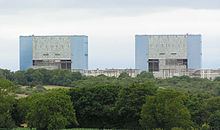Country England Decommission date 2000 | Status Decommissioned Construction began 1957 | |
 | ||
Owners | ||
Hinkley Point A nuclear power station is a decommissioned Magnox Nuclear power station located on a 19.4-hectare (48-acre) site in Somerset on the Bristol Channel coast, 5 miles (8 km) west of the River Parrett estuary.
Contents
HistoryEdit
Hinkley Point A was one of three Magnox power stations located close to the mouth of the River Severn and the Bristol Channel, the others being Oldbury, and Berkeley.
The construction of the power station, which was undertaken by a consortium backed by English Electric, Babcock & Wilcox Ltd and Taylor Woodrow Construction, began in 1957. The reactors and the turbines were supplied by English Electric.
The power station, which is currently being decommissioned, had two Magnox reactors, each supplying steam to three English Electric 93.5MW turbine generator sets which were all together across both reactors designed to produce 500 MWe but, after de-rating of the reactor power output due to corrosion concerns, both reactors combined produced 470 MWe.
The design followed the principles established by the Calder Hall nuclear power station, in that it used a reactor core of natural uranium fuel in Magnox alloy cans within a graphite moderator, all contained in a welded steel pressure vessel. The core was cooled by CO2 pumped by six nominal 7,000 hp (5.2MW) gas circulators, which transported the hot gas from the core to the six Steam Raising Units (boilers) via steel ducts. The gas circulators could be driven by induction motors supplied with mains electricity or, when steam was available, dedicated variable speed turbo alternator sets. The design pressure of the gas circuit was 185 psig, and the temperature of the gas leaving the reactor was 378 °C, although this was later reduced when the hot CO2 was found to be corroding the mild steel components of the gas circuit more quickly than had been anticipated. Like all Magnox reactors, Hinkley Point A was designed for on-load refuelling so that exhausted fuel elements could be replaced with fresh without shutting down the reactor.
While primarily planned for peaceful electricity generation, Hinkley Point A was modified so that weapons-grade plutonium could be extracted for military purposes should the need arise.
Like all other British Magnox power stations, Hinkley Point A had numerous backup systems to maintain an excellent safety record throughout its career. Emergency backup systems consisting of 5 x 1,050hp English Electric 8CSV Diesel Generating Sets were installed at the station, which provided power to both reactors gas circulation systems if external power was lost in the event of a SCRAM.
Gas circulator design problemEdit
In August 1963 during a hot run test on the first reactor, which had not then been loaded with nuclear fuel, problems were encountered due to noise from the single stage axial flow gas circulators. This could be heard up to five miles away, and personnel working at the station had to wear ear defenders. After unexplained drops in the mass flow rate and motor driving current in number 3 and 5 gas circulators, the hot run tests were stopped and the gas circuit opened up. Severe mechanical damage to the blading and diffuser sections of the number 3 and 5 gas circulators was observed. Large sections of the diffusers had broken away, and extensive fatigue cracking was found in the outer tapering shell and central axial cone. Large pieces of the diffuser casing had entered the gas circulator blades and caused heavy impact damage, and large amounts of debris had been transported down the gas duct. The Inlet Guide Vanes (IGVs), which were provided to enable the performance of individual gas circulators to be "trimmed," were found to be extensively damaged, and the rotor blades and outlet guide vanes also had extensive impact and fatigue damage. Large numbers of the nuts and bolts involved had been shaken loose.
The subsequent investigation determined that the noise was caused by interaction between the IGVs and the rotor blades. The sound pressure levels generated by this noise were high enough to cause rapid fatigue failure in gas circuit components, and major re-design of the gas circulators and associated components was required. The IGVs were scrapped and flow straighteners introduced to smooth the flow of gas into the gas circulator intakes. Much pioneering experimental laboratory work on resonance and sound pressure levels was performed at English Electric's Gas Turbine and Atomic Power Division (APD) facilities at Whetstone, Leicestershire, to support the redesign work, and instrumentation to measure stress and sound pressure levels in the gas circuit during testing was developed. The delay caused severe financial difficulties for the consortium and set the construction schedule back; the station began generating electricity two years late in 1965.
ClosureEdit
Both reactors were shut down in April 1999 to carry out reinforcement work following a Nuclear Installations Inspectorate Periodic Safety Review. Reactor 2 was returned to service in September 1999, but shut down on 3 December 1999 because of newly identified uncertainties in the reactor pressure vessel material properties. Because of the cost of remedying these problems, it was announced on 23 May 2000 that Hinkley Point A would be shut down.
Hinkley Point A was one of eleven Magnox nuclear power stations commissioned in the United Kingdom between 1956 and 1971. During its 35 years of operation, Hinkley Point A generated more than 103 TWh of electricity, giving a lifetime load factor against design of 34 %.
Site futureEdit
The Hinkley Point Site is currently organized as two nuclear power stations: Next to Hinkley Point A with its two Magnox reactor buildings there is Hinkley Point B, operated by EDF Energy, with two AGCR reactors in one building. In October 2013, the UK government announced that it had approved the construction of Hinkley Point C. This new plant, consisting of two EPR units, is scheduled to be completed in 2023 and remain operational for around 60 years.
